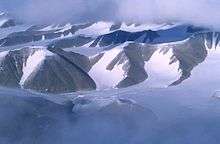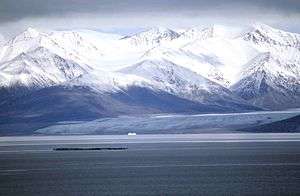Sirmilik National Park
Understand
Sirmilik National Park, nearest the town of Pond Inlet, covers an area of 22,200 km² (8,600 sq mi), which is larger than El Salvador.

Situated within the Arctic Cordillera, the park is composed of three areas: most of Bylot Island with the exception for a few areas that are Inuit-owned lands, Oliver Sound, and Baffin Island's Borden Peninsula. Much of the park is bordered by water.
Geographically, it is representative of the Northern Eastern Arctic Lowlands Natural Region and parts of the Lancaster Sound Marine Region.
In the Inuktitut (or Inuit language), Sirmilik means "place of glaciers". As Canadian Arctic Inuktitut-speakers referred to northern Baffin Island as Sirmilik, the name of the geographic region became the name of the national park.
Contact the park office +1 867-899-8092, toll-free +1-888-773-8888, or email: sirmilik.info@pc.gc.ca
History
Extensive archaeological exploration of the park area has indicated that the area has been inhabited by humans for thousands of years. The earliest known are predecessors of the modern-day Inuit.
The area was explored by European whalers and by explorers in their search for the Northwest Passage. In the 1610s, the area was surveyed by British explorers William Baffin and Robert Bylot. They named several features of the area including Lancaster Sound and Bylot Island in 1616. It was 200 years before the next official attempt to find the Passage through this area. The expedition by the British explorer John Ross in 1818 confirmed the accuracy of Baffin's charts, but ended when he saw what he believed were mountains blocking the end of Lancaster Sound. The area was later thoroughly explored during an extensive aerial mapping program of Northern Canada by the Canadian Government which took from the 1930s until the late 1950s to complete.
The Byam Martin Mountains on Bylot Island were climbed by Pat Biard and then Ben Farris in 1954, including Mount Thule. In 1963 British explorer Bill Tilman traversed the island, but did not climb any of the larger peaks. In 1977, a Canadian expedition of Rob Kelly and others climbed 20 peaks of Bylot Island, and in 1984 Mike Schmidt with others climbed 28 peaks, including 16 first ascents.
The park was established as a bird sanctuary in 1965 and monitored by the Canadian Wildlife Service because of its seabird colonies. The area became a national park in 2001. Today, the area is inhabited by the Inuit who continue to hunt and fish as their ancestors did.
Landscape

The park consists of three land and marine components. These are Oliver Sound, to the south of Pond Inlet, characterised by a long narrow fjord flanked by towering cliffs and glaciers, the plateau and river valleys of the Borden Peninsula and Baillarge Bay, and finally Bylot Island, characterised by its rough terrain with mountains, coastal lowlands, icefields and glaciers. Hoodoos are unique eroded formations on Bylot Island and the Borden Peninsula. Evidence shows that the area was scoured by the Laurentide ice sheet, a massive sheet of ice that covered hundreds of thousands of square kilometers at least 20,000 years ago.
The Borden Peninsula extends north for 225 km (140 mi) and is 64 km (40 mi) – 169 km (105 mi) wide. The northern area, including the Hartz Mountains, are composed of flat, dissected rock rising to over 914 m (2,999 ft) above sea level. Admiralty Inlet forms a western border, with Elwin Inlet also to the west, while Navy Board Inlet forms a border to the east, separating the peninsula from Bylot Island. Navy Board Inlet's coastal cliffs rise to 457 m (1,499 ft).
Bylot Island lies off the northern end of Baffin Island and has an area of 11,067 km² (4,273 sq mi). It is also one of the largest uninhabited islands in the world. While there are no permanent settlements, Inuit from Pond Inlet and elsewhere regularly travel to Bylot Island. An Inuit seasonal hunting camp is southwest of Cape Graham Moore.
The Byam Martin Mountains extend from east to west across Bylot Island and are an extension of the Baffin Mountains which in turn form part of the Arctic Cordillera mountain system. The highest mountain in the range is Angilaaq Mountain, 1,951 m (6,401 ft), near the island's centre. The Byam Martin Mountains are made up of Archean-Aphebian igneous crystalline rock and Proterozoic metasedimentary and metamorphic rock, such as gneiss. Sharp peaks and ridges, divided by deep glacier-filled valleys are typical features in the range and has been extensively modified by glacial erosion. Extensive glaciers dot the island including the Kaparoqtalik Glacier. Vertical cliffs along the coastline are made up of Precambrian dolomite. The island's north shore faces Lancaster Sound, a polar bear maternity den area, also noted for its high concentrations of marine wildlife. To the northeast of the park is Baffin Bay and to the south lies Pond Inlet and Eclipse Sound.
Fauna
Beluga whales, seals, walruses, Peary caribou, Arctic foxes, Arctic hares and wolves are found in this park. Bylot Island is a migratory area for narwhals.[ Sirmilik is one of eight Canadian national parks that contains polar bears.
A major seabird colony is located in the area of Baillarge Bay. Seabird colonies are also on Bylot Island which have a large colony and nesting area of greater snow geese. More than 70 species of birds have been recorded here, of which about 40 are known to breed. The park is known to be an important bird sanctuary. In 1965, Bylot Island enclosed within the park was also declared as a "Migratory Bird Sanctuary" in view of the large number of migratory birds in the area. A record 100,000 birds are reported to pass the park during summer months every year, and the large geese population of the island is known to constitute the most abundant herbivores of the island. On some of Bylot Island's rugged cliffs within the park, thousands of nesting birds can be found including 300,000 thick-billed murre and 80,000 black-legged kittiwake.
Flora
The wetlands of the park (10% of the area) have abundant vegetation of water sedge (Carex aquatilis), white cottongrass (Eriophorum scheuchzeri) and tall cottongrass (Eriophorum angustifolium). Other types of grass include the Fisher’s tundragrass (Dupontia fisheri), the polar grass (Arctagrostis latifolia) and semaphore grass (Pleuropogon sabinei). In addition, several species of brown moss have been recorded. In the Arctic environment of the southern part of the island 360 species of plants have been documented, which are considered to have rare quality and productivity.
Vegetation in the upland (on hill slopes and terraces) which constitute 90% of southern drier areas of the park consist of forbs, such as Arctic heather (Cassiope tetragona), mountain avens (Dryas integrifolia), Arctic poppy (Papaver radicatum) and mountain sorrel (Oxyria digyna), grasses, such as polar grass (Arctagrostis latifolia), northern foxtail (Alopecurus alpinus), bluegrass (Poa arctica) and northern wood rush (Luzula confusa) and shrubs, such as Arctic willow (Salix arctica) and northern bilberry (Vaccinium uliginosum).
Climate

In the north of Baffin Island, there is a polar maritime climate which means long, cold winters and short, cool summers. The spring does not end until mid-June and the warmest period is late July and early August, with average maximum temperatures of 10 °C. The coldest month is January as the average maximum temperatures of about −30 °C. Rainfall is relatively abundant, contributing to the flora seen in the park.
Get in
Pond Inlet and Arctic Bay, Nunavut are Sirmilik National Park’s gateway communities, accessible by 3-hour commercial flights from Iqaluit. Local outfitters offer park boat or snowmobile shuttles, depending on the season.
The best times to visit are late March to early June and August to mid-September. Book well in advance; park registration, orientation and de-briefing are mandatory. Weather dictates travel schedules so it’s wise to factor in time for delays.
- To Iqaluit: First Air Ltd. and Canadian North fly direct to Iqaluit from Montreal, Ottawa & Yellowknife.
- Travel from Iqaluit to Pond Inlet or Arctic Bay (via Nanisivik): First Air offers scheduled flights from Iqaluit to Pond Inlet and Arctic Bay (via Nanisivik). Kenn Borek Air offers scheduled flights to Pond Inlet.
- To Sirmilik National Park: Travel to and from Sirmilik, from either Pond Inlet or Arctic Bay, can be arranged with local outfitters. Outfitters will take you to and from the park by either boat or snowmachine, depending on the season. In Pond Inlet, staff of the Nattinnak Visitor Centre can help you make the necessary arrangements with local outfitters, call +1 867-899-8226. Outfitter charges vary and should be discussed with the outfitter being hired. For more information on Arctic Bay, call +1 867-439-8483.
Fees and permits
Northern Park Backcountry Excursion/Camping Permit valid at Sirmilik, Auyuittuq, Ivvavik, Nahanni, Aulavik, Quttinirpaaq, Tuktut Nogait and Vuntut National Parks (per person, 2018):
- Daily $24.50
- Annual $147.20
Fishing permit:
- Daily $9.80
- Annual $34.30
Get around
See
Do
Boating
In the summer (late July to early September) Sirmilik is accessible only by water. The nearest community to Bylot Island is Pond Inlet, 25 km to the south, across Eclipse Sound. Local boat operators and guides are available in Pond Inlet or Arctic Bay to provide marine transportation to the park.
Tour operators must be licensed by Parks Canada to provide guiding and outfitting services inside Sirmilik National Park. Contact the Parks Canada office in Pond Inlet at +1 867 899-8092 for a list of operators.
Travelling by sea kayak is one way to experience Sirmilik for those who are very experienced and only in certain areas. Marine hazards include strong winds, adverse weather, floating ice, and tides. Boat transportation to drop-off and pick-up points is advised.
Marine points of interest
- Oliver Sound - Kangiqluruluk: south of Pond Inlet, Oliver Sound features an immense scenic fiord with excellent opportunities for boating, sea kayaking, and camping. Its steep cliffs and valley glaciers provide some of Sirmilik's most impressive scenery, and its sheltered waters are ice-free relatively early in the summer season. Several large alpine glaciers come close to the sound, and are ideal places to explore. There are several good camping areas along the shore, and many opportunities for day hikes into the adjacent uplands.
- Lancaster Sound - Tallurutiup imanga: This very large body of water between Devon Island and Sirmilik is one of the most productive marine areas in the entire Canadian arctic. It is home to abundant populations of seabirds, walrus, polar bear, and several species of seal and whale. It is also the eastern entrance to the Northwest Passage and an important route for marine transportation.
- Eclipse Sound - Tasiuja: The main marine transportation route to Bylot Island, Navy Board Inlet and Borden Peninsula. It is often covered by pack ice until mid-summer, and travel can be dangerous due to strong winds, currents, and high waves. There is abundant marine life in the sound, including narwhals and polar bears. Spectacular icebergs add to the local scenery. Some become grounded in shallow waters, remaining in Eclipse Sound for several years before floating into Baffin Bay.
- Navy Board Inlet - Nalluata imanga: The main access corridor to the park's Borden Peninsula, Cape Hay and Lancaster Sound. The scenery is impressive, and several glaciers descend abruptly to the shoreline just north of Low Point.
